Chinese Hanfu clothing, the traditional attire of the Han Chinese, holds a profound cultural significance that transcends time. Understanding its rich heritage is key to appreciating its value in today’s world. This blog delves into the origins, styles, and cultural implications of Hanfu, shedding light on a timeless tradition that continues to captivate hearts globally.
History and Evolution

Early Beginnings
Hanfu’s evolution from the Shang Dynasty to modern times has been a remarkable journey, showcasing the enduring appeal of this traditional attire. The basic Hanfu form took shape during Xia, Shang, and Zhou Dynasties, solidifying its place in Chinese culture. Throughout history, Hanfu has gone through several iterations, providing contemporary enthusiasts with more choices.
Shang Dynasty Origins
During the Shang Dynasty, Hanfu began to establish its distinctive style and cultural significance. Han clothing became synonymous with elegance and tradition, setting the foundation for future developments. The intricate designs and symbolic meanings embedded in the garments reflected the values cherished by the ancient Chinese civilization.
Development Through Dynasties
As time progressed, Hanfu continued to evolve, adapting to the changing dynasties and societal norms. From the reign of the Yellow Emperor to the end of the Ming Dynasty, Hanfu dominated the Chinese fashion world. Each dynasty added its unique touch to Hanfu, enriching its heritage and deepening its cultural roots.
Modern Revival
The 20th century witnessed a decline in the popularity of Hanfu as Western influences permeated Chinese society. However, in recent years, there has been a notable resurgence of interest in this traditional attire. People are rediscovering the beauty and significance of Hanfu, embracing it as a symbol of cultural pride and heritage preservation.
20th Century Decline
Amidst rapid modernization and globalization trends, traditional clothing like Hanfu faced challenges in maintaining relevance. The shift towards Western fashion norms led to a temporary decline in the wearing of Hanfu among the general population. Yet, its legacy endured through dedicated individuals committed to its revival.
21st Century Resurgence
In contrast to its decline in the previous century, the 21st century has seen a remarkable resurgence of Hanfu across China and beyond. Enthusiasts young and old are embracing this ancient attire with renewed enthusiasm, sparking a cultural reawakening. The revival of Hanfu reflects a growing appreciation for China’s rich heritage and sartorial traditions.
Styles and Elements

Traditional Styles
Ruqun for Women
In traditional Chinese culture, Ruqun holds a special place as a classic attire worn by women. This two-piece ensemble consists of a top and a skirt, symbolizing grace and elegance. The top features a cross collar and right lapel, tied with a sash instead of buttons. It represents the essence of femininity, with its flowing lines and intricate details. The skirt, typically ankle-length, adds a touch of sophistication to the overall look.
Shenyi for Men
For men, the Shenyi embodies traditional masculinity and cultural heritage. This attire comprises an upper garment and a lower robe, reflecting simplicity and refinement in its design. The loose-fitting silhouette allows for ease of movement while exuding a sense of dignity and tradition. The Shenyi is often complemented with accessories like belts or jade ornaments to enhance its aesthetic appeal.
Key Elements
Fabrics and Materials
The choice of fabrics and materials plays a crucial role in defining the authenticity and quality of Hanfu attire. Silk, known for its luxurious texture and sheen, is favored for its comfort and elegance. Cotton is also commonly used for its breathability and versatility. Additionally, brocade fabrics with intricate patterns are often incorporated to add richness to the garments. These materials not only enhance the visual appeal but also contribute to the overall wearing experience.
Colors and Patterns
Colors hold symbolic meanings in Chinese culture, influencing the selection of hues in Hanfu garments. Traditional colors such as red symbolize joy and prosperity, while blue signifies tranquility and harmony. Patterns like floral motifs or auspicious symbols are meticulously embroidered onto the fabric to convey deeper cultural significance. Each color combination and pattern choice reflects historical traditions and personal preferences.
Cultural Significance
In the realm of Chinese Hanfu clothing, every stitch and motif carries a profound significance that transcends mere fabric. The attire serves as a living testament to cultural heritage, weaving together threads of tradition and history in a tapestry of elegance. Embracing Hanfu symbolizes a deep-rooted connection to one’s roots, echoing the values and virtues passed down through generations.
Symbolism
Connection to Heritage
Wearing Hanfu is akin to stepping into the footsteps of ancestors, embodying a legacy that stretches back millennia. Each garment tells a story of resilience, grace, and cultural pride, encapsulating the essence of Chinese identity. By donning Hanfu, individuals forge a tangible link to their past, honoring the sacrifices and triumphs of those who came before.
Representation of Values
Within the intricate folds of Hanfu lies a treasure trove of values cherished by the Chinese civilization. Respect for tradition, harmony with nature, and reverence for family are intricately woven into the fabric of every garment. Through these timeless motifs and designs, Hanfu becomes more than attire; it becomes a visual ode to the enduring principles that define Chinese culture.
Contemporary Relevance
Cultural Preservation
Amidst the winds of change and modernization, Hanfu stands as a bastion of cultural preservation. The resurgence of interest in traditional attire reflects a collective desire to safeguard China’s rich heritage from fading into obscurity. Through wearing Hanfu with pride and reverence, individuals become stewards of tradition, ensuring that ancient customs endure for future generations.
Global Appreciation
Beyond its borders, Hanfu has captured hearts worldwide as a symbol of sartorial splendor and cultural exchange. Enthusiasts from diverse backgrounds embrace this traditional attire not just as clothing but as an embodiment of cross-cultural appreciation. By donning Hanfu respectfully and authentically, individuals bridge continents through shared admiration for China’s artistic legacy.
- The Hanfu Movement serves as a cultural bridge, allowing individuals to reconnect with their heritage and express their identity through attire.
- Wearing Hanfu symbolizes a reclaiming of personal expression, especially in the context of historical restrictions on cultural identity during the Cultural Revolution.
- Today, the resurgence of Hanfu represents a newfound freedom for individuals to embrace their roots and celebrate the beauty of traditional Chinese craftsmanship and design.






